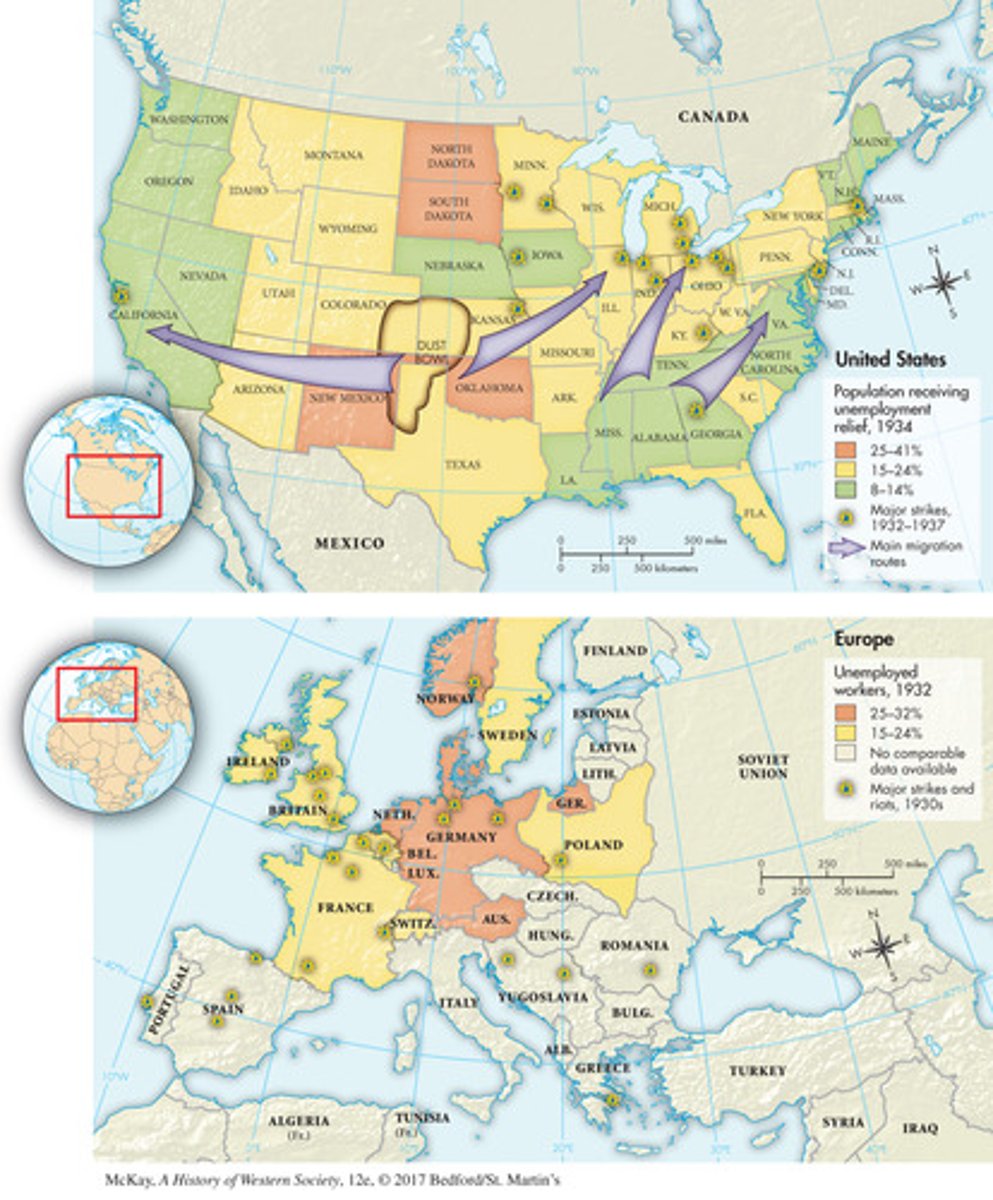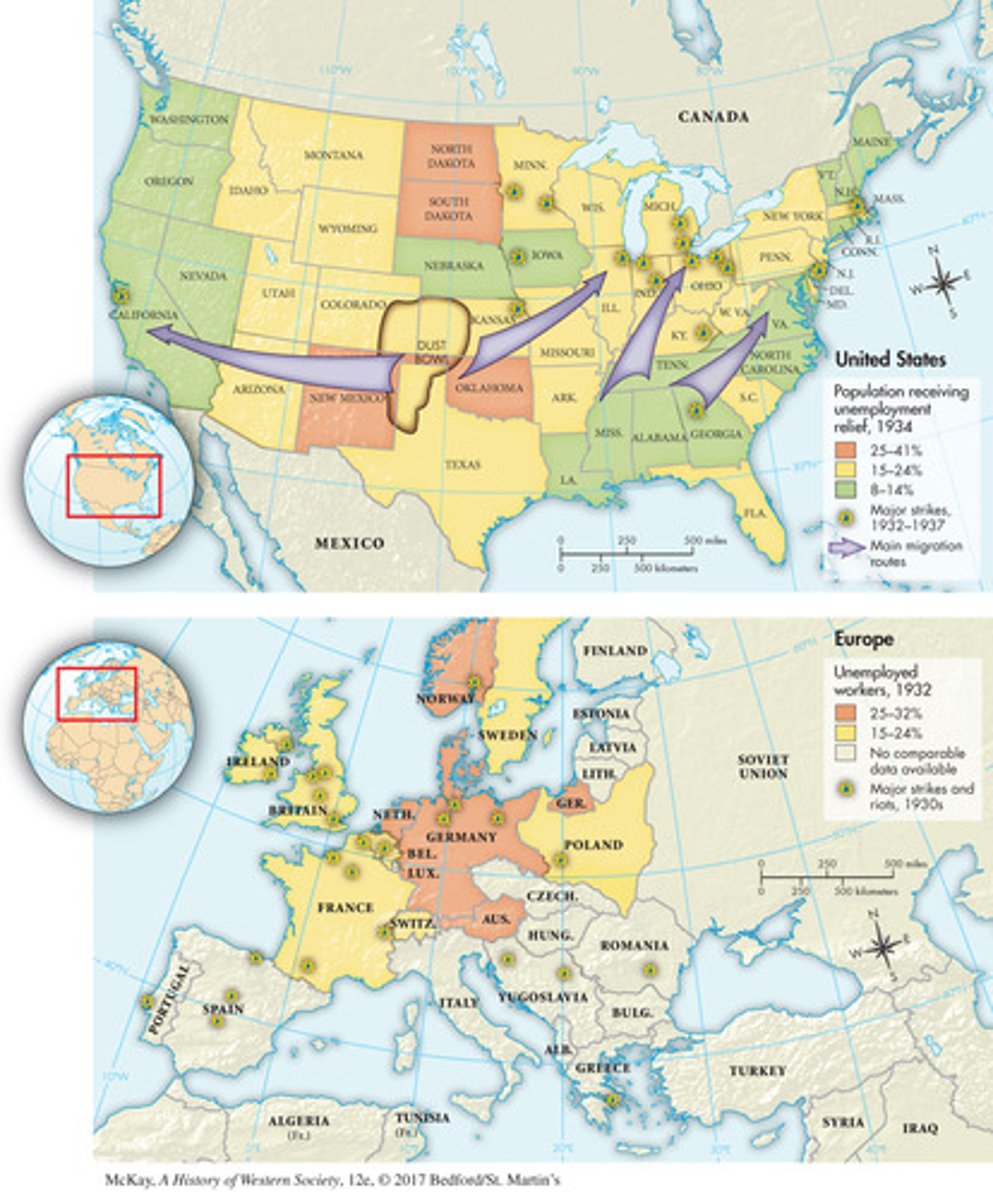AP Euro Chapter 26
1/59
There's no tags or description
Looks like no tags are added yet.
Name | Mastery | Learn | Test | Matching | Spaced |
|---|
No study sessions yet.
60 Terms
In the early twentieth century, the traditional arts and amusements of people in villages and small towns were overshadowed by
modern mass media such as cinema and radio.
"When you see the unemployment figures quoted at two millions, it is fatally easy to take this as meaning that two million people are out of work and the rest of the population is comparatively comfortable. . . .This is an enormous under-estimate, because, in the first place, the only people shown on unemployment figures are those actually drawing the dole—that is, in general, heads of families. An unemployed man's dependants do not figure on the list unless they too are drawing a separate allowance. . . . In addition there are great numbers of people who are in work but who, from a financial point of view, might equally be unemployed, because they are not drawing anything that can be described as a living wage."
Why did Orwell think that unemployment figures underestimated the number of people who were in dire economic straits?
The statistics did not include the family members of the unemployed.
What kind of world did Franz Kafka portray in fiction like The Trial (1925)?
A pessimistic world in which helpless individuals are crushed by inexplicably hostile forces
How did Jean-Paul Sartre think that people could live authentically in the twentieth century?
They must choose their actions fully aware of their responsibility for their behavior.
In the twentieth century, what was John Maynard Keynes known for?
He denounced the Treaty of Versailles for economic reasons.
The American stock market crash of October 1929 was primarily the result of
an imbalance between real investment and speculation.
Which political group dominated the parliamentary governments of Germany in the mid to late 1920s?
Moderate businessmen
What did President Franklin Roosevelt's National Recovery Administration (NRA) attempt to do?
Plan and control the U.S. economy
Why was Britain more ready to conciliate Germany than France following the Versailles peace settlement?
British had depended heavily on the German market for their exports before World War I.
For artists such as the Dadaists and Surrealists, what was the purpose of art?
To expose the bankruptcy of modern society and produce radical social change
According to Map 26.1: The Great Depression in the United States and Europe, 1929-1939, which American states contain the highest percentage of population receiving unemployment relief in 1934?
North Dakota, South Dakota, Oklahoma, and New Mexico

Who was the director of Triumph of the Will, a brilliant piece of cinematic propaganda based on the 1934 Nazi Party rally at Nuremberg?
Leni Riefenstahl
What does the "middle way" refer to?
The Scandinavian response to the Great Depression
In the twentieth century, Werner Heisenburg established the "uncertainty principle," which postulates that
nature itself is ultimately unknowable and unpredictable and lacks any absolute objective reality.
"8. We stand on the last promontory of the centuries! . . . Why should we look back, when what we want is to break down the mysterious doors of the Impossible? Time and Space died yesterday. We already live in the absolute, because we have created eternal, omnipresent speed. 9. We will glorify war—the world's only hygiene—militarism, patriotism, the destructive gesture of freedom-bringers, beautiful ideas worth dying for, and scorn for woman. 10. We will destroy the museums, libraries, academies of every kind, will fight moralism, feminism, every opportunistic or utilitarian cowardice."
How did Marinetti and the Futurists see war?
War and its ideals will be idolized by Futurists.
What did Marcel Proust attempt to do in his novel Remembrance of Things Past?
Discover the inner meaning of bittersweet memories of childhood and youthful love
What agreement did the United States develop to resolve the economic problems of Germany and international tensions in Europe in 1924?
Dawes Plan
Using Map 26.1: The Great Depression in the United States and Europe, 1929-1939, explain the relationship between unemployment and rioting.
Countries with moderate unemployment experienced more strikes and riots.

What was the main argument of logical positivism in the twentieth century?
Philosophy is only the logical clarification of thoughts.
"[The poor and the unemployed] don't necessarily lower their standards by cutting out luxuries and concentrating on necessities; more often it is the other way about—the more natural way, if you come to think of it. Hence the fact that in a decade of unparalleled depression, the consumption of all cheap luxuries has increased. The two things that have probably made the greatest difference of all are the movies and the mass-production of cheap smart clothes since the war. The youth who leaves school at fourteen and gets a blind-alley job is out of work at twenty, probably for life; but for two pounds ten on the hire-purchase system he can buy himself a suit which, for a little while and at a little distance, looks as though it had been tailored in Savile Row."
According to Orwell, the depression led to
an increase in the consumption of cheap luxury items.
The signatories of the 1928 Kellogg-Briand Pact, initiated by French prime minister Aristide Briand and U.S. secretary of state Frank B. Kellogg, agreed to
renounce war as an instrument of international policy.
What was an important factor in both the rapid growth of the American stock market in the 1920s and its collapse in October 1929?
Buying on margin
What did orthodox economists believe in the 1930s?
Balanced budgets were the key to economic growth
In his philosophical writings, Friedrich Nietzsche argued that
the Western world had overemphasized rationality and stifled the authentic passions that drive human activity and true creativity.
In twentieth-century literature, the stream-of-consciousness technique uses
internal monologues to explore the psyche.
What did Jean-Paul Sartre mean by the expression "existence precedes essence"?
Since there are no timeless or absolute truths, people must struggle to define their essence after they are born, completely on their own.
Unemployment in the United States averaged only 5 percent in the 1920s but in 1933 soared to about
30 percent.
How did France and Belgium react when Germany refused to make its second reparations payment?
They occupied the Ruhr district.
In 1923, which German politician called off passive resistance in the Ruhr and agreed in principle to pay reparations?
Gustav Stresemann
The nineteenth-century Danish theologian Søren Kierkegaard taught that
God's existence could not be proven, but believers must take a leap of faith and accept the existence of a majestic God.
The following is an excerpt from Nietzsche's The Gay Science (Evaluating Written Evidence):
"The Madman. Haven't you heard of that madman, who on a bright morning day lit a lantern, ran into the marketplace, and screamed incessantly: 'I am looking for God! I am looking for God!' Since there were a lot of people standing around who did not believe in God, he only aroused great laughter. Is he lost? asked one person. Did he lose his way like a child? asked another. Or is he in hiding? Is he frightened of us? Has he gone on a journey? Or emigrated? And so they screamed and laughed. The madman leaped into the crowd and stared straight at them. 'Where has God gone?' he cried. 'I will tell you! We have killed him.You and I! All of us are his murderers!'"
Nietzsche believed that God had been killed by
modern society
Why was the Great Depression slow to affect France?
France was less industrialized than the other major continental powers in Europe and somewhat isolated from the world economy.
What was the British political party that emerged during the 1920s as the main opposition to the Conservative party?
Labour Party
The German government's printing of money to pay unemployment benefits to workers striking in the Ruhr against the Franco-Belgian occupation of 1923 led to
hyperinflation.
What did the theories of Albert Einstein assert?
Matter and energy are interchangeable, linking the apparently infinite universe with the subatomic world.
What did the Swedish response to the Depression involve?
Increasing social welfare benefits and state spending on public works projects
What is the composer Arnold Schönberg known for?
His creation of twelve-tone music that abandoned traditional harmony and tonality
What idea does the functionalist architecture of Le Corbusier promote?
Buildings should be built without ornamentation and instead be practical structures with clean, straight lines.
According to Map 26.1: The Great Depression in the United States and Europe, 1929-1939, which European countries had the highest levels of unemployment?
Germany, Norway, and Austria

Why did Britain's abandonment of the gold standard not aid its recovery?
Many other wealthy countries abandoned the gold standard after Britain, blunting any advantage for Britain.
In his writings on human psychology, Sigmund Freud asserted that
the id is the unconscious source of sexual and aggressive instincts.
The German Communist Party, noisy and active in the 1920s, reserved their greatest hatred and sharpest barbs for
Social Democrats.
James Joyce's Ulysses weaves ironic parallels between the adventures of Homer's hero Ulysses and
an ordinary man's aimless wanderings through the streets and pubs of Dublin.
What did the Popular Front do after its 1936 victory in France?
It encouraged the union movement and launched a far-reaching program of social reforms that included a forty-hour workweek.
The Great Depression did not hit Britain as hard as the United States or Germany in part because
the British economy had moved away from international markets and toward production of goods for the domestic market.
In Civilization and Its Discontents (1930), Freud argued that civilization required
individuals to renounce their irrational instincts in order to live peaceably in groups.
With the failure of the United States to ratify the Versailles treaty, many French leaders placed their hopes for future security on
strict implementation of the treaty.
According to Map 26.1: The Great Depression in the United States and Europe, 1929-1939, which American states were in the Dust Bowl?
New Mexico, Colorado, Kansas, Oklahoma, and Texas

According to Nietzsche in On the Genealogy of Morals, God had been killed by
apathetic and unbelieving Christians.
In art, music, architecture, and literature, modernists
shattered long-held assumptions about form and function.
The stereotypical "modern girl" of the 1920s was differentiated from her predecessors by her
social and political independence.
Which statement accurately characterizes how the development of radio differed in the United States and Europe?
In the United States, radio broadcasters were private enterprises, but in Europe, they were often arms of the state.
In 1923, who attempted to overthrow the German government in the so-called Beer Hall Putsch?
Adolf Hitler
The U.S. and Scandinavian responses to the Great Depression after 1933 were similar in that in both countries,
government spending was increased to bring people back to work.
France's Popular Front was formed in response to
the growth of fascism.
Gabriel Marcel found the answer to the post-war broken world in
the Catholic Church.
Which artistic movement sought to capture the momentary overall feeling of light falling on a real-life scene?
Impressionists.
In The Decline of the West, Oswald Spengler argued that
the West would soon be conquered by 'the yellow race'.
In 1925, which agreements gave Europeans a growing sense of security and stability in international affairs?
The Locarno Treaties (Locarno Pact).
Which party, founded by Léon Blum, led France's Popular Front government in the 1930s?
The Socialist party.